The keping was the currency of Terengganu until 1909 when it was replaced by the Straits dollar. [1] It was subdivided into 10 pitis. Coins were issued in denominations of 1 pitis (tin), 1 keping (copper) and 10 keping (tin).

The Brunei dollar, has been the currency of the Sultanate of Brunei since 1967. It is normally abbreviated with the dollar sign $, or alternatively B$ to distinguish it from other dollar-denominated currencies. It is divided into 100 sen (Malay) or cents (English). The Brunei dollar is issued by the Brunei Darussalam Central Bank.

The rupia was the currency of Portuguese India sometime after 1668 until 1958. Prior to 1668, the currency unit was Xerafim. In 1666, the Portuguese administration struck a silver coin calling it double xerafin and this was declared equal to a rupia in circulation in India outside of Portuguese possessions. A xerafim was a convertible subunit of rupia, and it was unique to Portuguese colonies in India. One rupia equalled two xerafims.
Pīti in Pali is a mental factor associated with the development of jhāna in Buddhist meditation. According to Buddhadasa Bhikkhu, piti is a stimulating, exciting and energizing quality, as opposed to the calmness of sukha.
The pitis was a currency of Brunei last issued in 1868 which circulated into the 20th century. It is also referred to as the picil by Antonio Pigafetta and some variants of it were referred to as the kue and the paku. It was later replaced by the Straits dollar in Brunei, which is valued at 4,000 pitis or 800 paku and at par with the Spanish dollar.
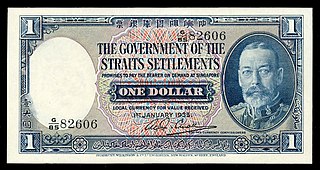
The Straits dollar was the currency of the Straits Settlements from 1898 until 1939. At the same time, it was also used in the Federated Malay States, the Unfederated Malay States, Kingdom of Sarawak, Brunei, and British North Borneo.
The pitis was a tin coin issued by several South-East Asian states. It may refer to:
The dollar was the currency of British colony of Bencoolen on the west coast of the island of Sumatra until the Anglo-Dutch Treaty of 1824, when the British Empire traded away Bencoolen for Malacca.

Abgoosht is an Iranian stew. It is also called dizi, which refers to the traditional stoneware crocks it is served in. Some describe it as a "hearty mutton Persian soup thickened with chickpeas."
The keping was the currency of Kelantan until 1909 when it was replaced by the Straits dollar. It was subdivided into 10 pitis. Coins were struck in tin in denominations of 1 pitis (holed), 1 and 10 keping.
The dollar was the currency of Penang between 1786 and 1826. It was subdivided into 100 cents, also called pice, and was equal to the Spanish dollar. The dollar was introduced after the East India Company acquired the island in 1786. In 1826, the Indian rupee was declared legal tender in Penang at a value of 48 pice. The dollar again became the currency of Penang with the introduction of the Straits dollar.

Line 7 of the Madrid Metro is a rapid transit line that originally opened on 17 July 1974. It runs between Pitis and Hospital del Henares.
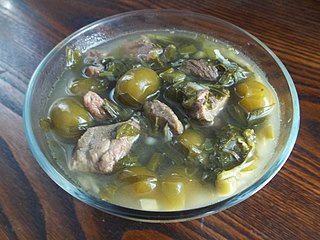
Chakapuli is a Georgian stew. It is considered to be one of the most popular dishes in Georgia.
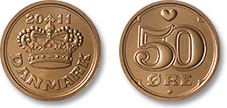
The fifty øre coin is the smallest-denomination coin of the Danish krone. Since the removal of the 25 øre coin in 2008, it has been the only Danish coin with a face value of under one krone.

Francisco Medina Luna, known as Piti, is a Spanish former professional footballer who played as a winger or a forward.
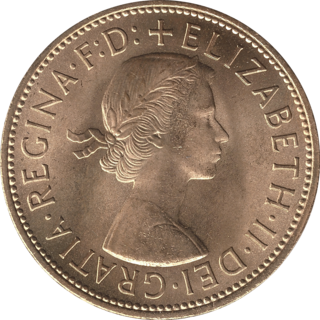
The British pre-decimal penny was a denomination of sterling coinage worth 1⁄240 of one pound or 1⁄12 of one shilling. Its symbol was d, from the Roman denarius. It was a continuation of the earlier English penny, and in Scotland it had the same monetary value as one pre-1707 Scottish shilling. The penny was originally minted in silver, but from the late 18th century it was minted in copper, and then after 1860 in bronze.

Although the vast majority of coins are round, coins are made in a variety of other shapes, including squares, diamonds, hexagons, heptagons, octagons, decagons, and dodecagons. They have also been struck with scalloped (wavy) edges, and with holes in the middle. Coins in the shape of polygons often have rounded edges or are Reuleaux polygons.
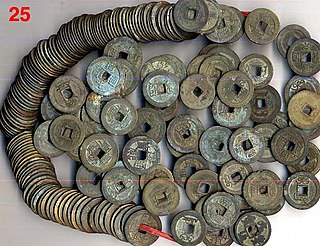
The cash coins of Indonesia was a historical currency in Indonesia based on Chinese imperial coinage during the Tang dynasty era. It was introduced by the Chinese traders, but it didn't reached its popularity in Indonesia until Singhasari defeated the Mongol empire in 13th century. Chinese cash coins continued to circulate in Indonesian archipelago for centuries; when the Ming dynasty banned trade with the region many local rulers started creating their own imitations of Chinese cash coins which were often thinner and of inferior quality. Cash coins produced in Indonesia were made from various materials such as copper-alloys, lead, and most commonly tin.

The Palembang pitis was a currency issued by the Palembang Sultanate from the 1600s until 1825 when the sultanate was dissolved and its territory taken over by the colonial government of the Dutch East Indies. The currency consisted of low denomination tin alloy coins which were mostly traded in bulk. Due to the lack of a centralized mint, the pitis often had inconsistent manufacture and were frequently counterfeited.
The 5 sen note (五銭紙幣) was a denomination of Japanese yen that was issued nonconsecutively from 1944 to 1948 in paper form. Five sen notes were worth one-twentieth of a yen making them the lowest subsidiary yen banknote ever made. These notes are broken up into two types which were issued before and after World War II. Those issued before the war filled a void left when 5 sen coin production became difficult. The second and final issue came after the war when the Japanese government tried unsuccessfully to curb inflation. Neither of these notes are currently legal tender as the "sen" was abolished in 1953 when the yen system was modified to exclude the old fractional currency. These banknotes are now easily collectable and affordable as they were issued in large amounts.
{{cite book}}: CS1 maint: others (link)